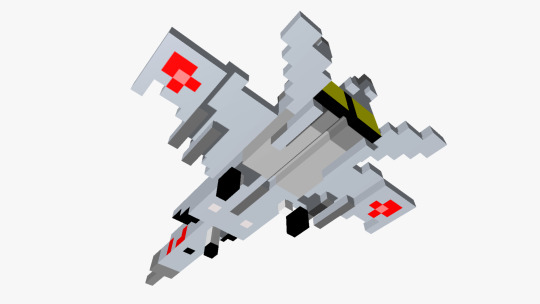#MiG 25 foxbat
Text

9 September 1964. First flight of the Ye-155-P1. Soviet supersonic fighter interceptor prototype of the Mig-25 Foxbat.
@ron_eisele via X
#mig 25 foxbat#mikoyan gurevich aviation#interceptor#russian air force#aircraft#aviation#cold war aircraft
14 notes
·
View notes
Text



On Sep. 6, 1976, the inhabitants of the Japanese city of Hakodate on the island of Hokkaido, turned their eyes to the sky, an airplane flew over the roofs of their houses at a very low altitude. With just two minutes of fuel, Viktor Belenko, desperately looking for a place to land, finally in front of him appeared Hakodate International airport, in the city of the same name.
53 notes
·
View notes
Text

a little world building here
Here are 2 of 5 identified Pelagic type airewyverns
Pelagic Type 1: Known for their fast adapting abilities and likeness to MIG-25s. Type 1 are usually found in northern waters, but there are reports of sightings in topical ocean, usually feed on big bony fishes, squids and mammals. Like most of the pelagic types they are solitary predators but will school up even with other airewyvens for taking down bigger preys. Like most of the pelagic wyverns they are aggressive to humans fishing in their waters and protective to sharks and orcas(they seem to very respect them), practice extreme caution around them.
Pelagic Type 2: A nocturnally active generalist apex predator resemble F-15 Eagles, type 2 can be found in deep waters of major oceans and occasionally coastal surface waters. They have high tolerance to toxins, making them navigating polluted waters easy. Their diet are so varied, they are known for eating or chewing inedible objects such as undersea cables. Like other pelagic wyverns they are protective to sharks and orca, even would swim and fly over orca pods to protect them. Type 2 are suspected to have hereditary schizophrenia.
#my art#my oc#airewyverns#doodle#dragons#aeromorph#mig 25#f15eagle#mig25 foxbat#shark#shark jetsss#I really suck at writing but I love world building#worldbuilding
143 notes
·
View notes
Text

A MiG-25 Foxbat taking off
7 notes
·
View notes
Text

Eagle Data File No. 37 from Eagle No. 66, dated 25 June 1983. The Mig-25 Foxbat. A bit of a worry to the West until Viktor Belenko, a defecting pilot, flew a new one to Japan on the 6 September 1976. Subsequent tests found it wasn't as powerful as they initially feared.
The artwork is by Lionel Jeans (given away by the Jeans signature) and I think he provided both the painted artwork and the cutaway.
12 notes
·
View notes
Text
Viktor Belenko
They're all dropping off this week!

On the 6th September 1976, Lieutenant Viktor Belenko of the Russian Air Force, said 'Screw you Commie bastards!' and defected.

In lieu of his last month's paycheck, he decided to fly off with his trusty Mig 25 Foxbat (see above).
The fact it was the most secret and most feared jet fighter of the time - and he was about to cause the sweet succulent granny of international incidents - as far as he was concerned wasn't going to be an issue. For him, at any rate. He hated Soviet Russia, was estranged from his wife, and his son was an asshole, so he'd nothing to lose.
What made the Foxbat so feared was its speed - Mach 3. Only the Lockheed Blackbird spy plane flew that fast - which was the point of the Foxbat's existence, although ironically there has never been a single example of a Foxbat and a Blackbird going toe to toe.
However, once an example had landed, a lot of the myths about the jet were exploded, and a few new ones thrown in. It turned out to have more in common with the British English Electric Lightning than anything more sophisticated, right down to its fully turning horizontal tail fins.
It was literally a Tonka Toy jet - big, heavy, crude, but very durable, right down to being able to be fitted with old fashioned valves rather than silicone chips, meaning it could survive the EMP pulse from a nuclear weapon.
Even its missiles - the Acrid - were a lightning fast blunt instrument that could fly far and fast to blow any other plane no matter how large out of the sky.
The point of the Foxbat was it could take off and climb at very short notice, very high, and very quickly, to intercept just about anything. One even managed to shoot down a communications satellite in low orbit.
Most embarrassing of all, the Foxbat's weapons and radar onboard computer - one of the first jets to have on - was an IBM make. To this day, there has never been a satisfactory explanation as to how Soviet Russia had such sophisticated American equipment in their military jets, but the conspiracy theorists had a field day.
It also spelt disaster for Egypt, Syria and Libya, who'd bought the jets at great expense hoping to have an edge over Israel, only to discover from the revelations from Belenko that the Foxbat wasn't much good at low level due to its weight - the Israeli Air Force's preferred combat tactic.
It also turned out their pilots couldn't handle the jet very well either - in fact only one foreign purchaser ever achieved happy results with the Foxbat, and that was India, who bought it to keep the Chinese, Pakistanis and - ironically - Russians out of their airspace.

Belenko's defection - quite aside from quenching Cold War and Middle East tensions once the Soviet's 'wonder weapon' was demystified - also inspired Craig Thomas' book (and later Clint Eastwood film) Firefox - although it would be a long time before any thought control aircraft system was to appear, even so at a very crude level.
A real Mig 31 was to appear however a few years later, the Foxhound, really the Mark II version of the Foxbat, flying also at Mach 3, and being the first jet to have 'Look Down, Shoot Down' - meaning it could shoot down or fire at targets beyond its onboard range due to the curve of the earth.
As for Belenko, he went on to work in the aircraft industry and attending flight enthusiasts meetings - unlike so many defectors, he did not find himself assassinated by "Mother Russia".
0 notes
Text
What I wrote...
and then took down was a meandering reminiscence about the "Crimean Massandra" comment that Vladimir Putin made at Theresa May's expense in 2017. It landed in the febrile post-referendum UK political environment like an unexploded grenade—the underlying menace was keenly felt but no one was quite sure how to respond.
In a now-deleted post, I muddled through the 2017 timeline,* forgetting exactly the sequence of events and had to correct myself but, in essence, what I said was that I still return to that comment from time to time—because it happened to coincide with a very significant period of my life.
And, today, I was thinking about MiGs and it occurred to me that "Mas[s]andra", which is a nickname associated with the MiG-25, could also signify "Foxbat" which is the MiG-25's NATO Reporting name.
The Foxbat–the fastest plane to enter military service, with one of the highest service ceilings–was an extraordinary plane with a thrilling history. Here's a video if you're interested.
Anyway, I don't think that observation is outlandish, which is why I'm making this quick post to record the thought again.
As for my other work...well, if I still had my "#dailyslang" hat on, I'd say that Fox is Animals and "Bat" is Murciélago and there's no reason why someone shouldn't use the phrase "Crimean [Foxbat]" to try to notify their presence in, or shipment through, Crimea.
*The comment was made in November 2017, more than three years after the annexation of Crimea, and shortly after the British Government had accused Russia of "cyber-espionage" and disinformation but before the Salisbury poisoning incident in 2018, which was also attributed to Russia.
0 notes
Photo










Model of the Mikoyan Gurevich MiG-25 (NATO code Foxbat) pixelated
Link to see more about this model on Turbosquid.com:
https://www.turbosquid.com/3d-models/3d-mig25-pixelated-1966693?referral=amanitacz
Link to the whole gallery:
https://www.turbosquid.com/Search/Artists/amanitacz?referral=amanitacz
Link to the software:
http://www.cazaba.cz/
#graphic#computer graphics#amanitacz#cazaba#3d#model#3d model#TurboSquid#Mikoyan#Gurevich#mikoyan gurevich#MiG-25#MiG25#Foxbat#russia#USSR#jet#fighter#air#aircraft#airplane#supersonic#hypersonic#ambush#interceptor#pixelated#pixel#art#pixel art
1 note
·
View note
Text

Mikoyan-Gurevich MiG-25 'Foxbat'
20 notes
·
View notes
Photo

MiG-25 Foxbat, one of the highest-flying military aircraft (89,000 ft) one of the fastest serially produced interceptor aircraft, and the second-fastest serially produced aircraft after the SR-71.
27 notes
·
View notes
Text

Ability to intercept an SR-71: Victor Belenko states the Mig-25 cannot intercept the SR-71 for several reasons: The SR-71 fly too high and too fast; the Mig cannot reach it or catch it. The missiles lack the velocity to overtake the SR-71 and in the event of a head on missile fire (The Golden BB), the Guidance system cannot adjust to the high closure rate of the SR-71.
The Mig-25 has a jam proof radar but cannot distinguish targets below 1,640 feet due to ground clutter. The radar was so powerful it could burn through jamming signals by approaching bombers.
Upon dismantling the Mig-25, the data was analyzed by the Foreign Technology Division of the Air Force at Dayton, Ohio. There were many surprises:
1The Mig had been manufactured in February 1976 and thus was one of their latest most sophisticated production aircraft.
2Transistor circuitry was not used but instead the Soviets relied on vacuum tubes for most of their electronics. The Soviets reasoned the vacuum tubes were less affected by EMP waves in the case of nuclear attack; were more resistant to temperature extremes and they were easy to replace in remote airfields where transistors may not be readily available if repairs were needed.
3Welding was done by hand.
4Rivet heads were exposed in areas not critical to parasitic aerodynamic drag.
5Pilot forward vision was highly obstructed.
6With huge Tumansky R-15D-300 engines the Mig was considered almost a rocket.
7Pilots were forbidden to exceed Mach 2.5. There was a total of three engine instruments and the airspeed indicator was redlined at 2.8 Mach.
8Above Mach 2.8 the engines would overheat and burn up. The Americans had clocked a Mig-25 over Israel at Mach 3.2 in 1973. Upon landing in Egypt, the engines were totally destroyed. We did not understand that the engine destruction was inevitable.
9The combat radius is 186 miles.
10Without using afterburner; staying at optimum altitude and not maneuvering, the Mig can fly in a straight line for 744 miles.
11The plane was so heavy at 64,200 pounds, that according to early rumors Soviet designers had to eliminate a pilot ejection system. However this was disproved. Most MiG-25s used the KM-1 ejector seat. The last versions used an early variant of the famous K-36 seat. The speed record for the fastest successful ejection (Mach 2.67) is held by a KM-1 equipped MiG-25.
12Maximum operational altitude: Carrying two missiles, 78,740 feet (for maximum two minutes duration); carrying four missiles, 68,900 feet is maximum.
13Maximum altitude of missiles: 88,588 feet.
14Maximum G load: With full fuel tanks 2.2 G's is max; with near empty fuel tanks, 5 G's is dangerous. The Mig-25 cannot turn inside a U.S. F-4 Phantom fighter!
15The plane was made of steel alloy, not high temperature titanium, although strips of titanium was used in areas of high heat concentration.
16In a tight turn the missiles could be ripped from the wings. thesr71blackbird.com/Aircraft/Stori…
@Habubrats71 via X
21 notes
·
View notes
Note
Possibly a naive question but giving Russia's embarrassing failures how is it that Russia and to an extent the Soviet Union be advanced in things like Nuclear Weapons, Aerospace Rocketry and other technologies and be such an abject failure in basic economic and military affairs? Or was it always a house of cards and Russia has always been a step behind?
It's not a naïve question. There are several factors.
The Soviet Union was a highly-militarized police state, they kept most of the country in a low standard of living and devoted a high percentage of their budget (roughly 18-20%, over two times that of the USA). Almost all of their intellectual capital went to military research and design, and so they were able to develop successes, particularly when it came to rocketry, since rocketry could help design better missiles to increase deterrence and better project Soviet power. However, as there was little in the way of consumer goods, this left the Soviet population relatively impoverished. This is actually a significant point of difference with modern Russia, who only devotes a fraction of that percentage to their military. However, they are not in a superpower conflict despite Russian domestic propaganda claims. Russian conflict in the post-Soviet era have primarily been against small nations, and notably the Russians have taken disproportionately high casualties.
A lot of Soviet nuclear engineering was enabled through espionage. First Lightning aka "Joe-1," the first Soviet nuclear bomb, was almost completely enabled through Manhattan Project research stolen by Soviet spies and ideological supporters within the project. To a lesser extent, the Soviet Union relied heavily on the theft of Western technological designs through the KGB's Directorate T, also called the Line X program. Russia today relies heavily on Western components for their higher-grade systems, particularly guidance chips for their PGM's. They've been sanctioned for years and it shows, the industrial capacity to replace Kalibr cruise missiles simply isn't present.
A lot of advanced Soviet engineering was actually not as advanced as you might think. The MiG-25 "Foxbat" supersonic interceptor was perceived as an ultra-maneuverable aviation threat, when in fact, the large wings did not mean exceptional maneuverability, but rather the Foxbat required large wings because the entire aircraft was made out of stainless steel and so it needed the extra wingspan simply to produce lift to cancel out the plane's high weight. It's high speed couldn't be sustained and so its only real use was attempting to chase down the SR-71 Blackbird, which it couldn't do because it was slower, couldn't fly as high, and in order to be capable, needed to strip off its armaments. Russia's corruption problems, as shown with its supply problems and equipment shortfalls, has shown that a lot of "advanced" Russian military capabilities are only that on paper.
The Soviet Union was never an economic superpower that could compete with the United States. From a GDP per capita position, the USSR was weaker than Western Europe, even weaker than some of its own Warsaw Pact puppet states. Even in aggregate, the USSR was never larger than Western Europe as its own bloc. So in that sense, it couldn't compete in delivering economic coherence or broad prosperity even if it had wanted to - its economic theories were flawed and it simply couldn't compete either as a producer of high quantities of average goods (as production quality in the USSR was very haphazard nor was there any solicitation of end-user feedback) nor in a knowledge economy producing high-quality finished goods (as the technical and intellectual capital wasn't present).
So as you can see, it's a variety of factors. The USSR was far from the complete and utter basket case that its detractors painted it as, and they could enjoy some successes, but by and large, economically it was an absolute mess and its military was propped up largely due to the consumption of the consumer economy and the idea that mutually assured destruction could mean that conventional warfare with their rival was a truly undesirable state of affairs.
Thanks for the question, James.
SomethingLikeALawyer, Hand of the King
41 notes
·
View notes
Text

MiG-25 Foxbat A
2 notes
·
View notes
Text

MiG-25 Foxbat
13 notes
·
View notes
